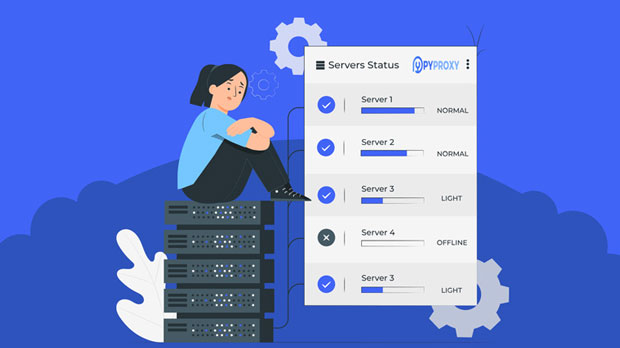How to Analyze Overseas Markets with Free Proxy Server IP?
In today’s globalized economy, analyzing overseas markets is crucial for businesses aiming to expand their reach and increase competitiveness. One of the most effective tools for conducting market research in foreign regions is through proxy servers. free proxy server ips allow businesses and individuals to gather data from different countries without being restricted by geographical limitations. By simulating local IP addresses, users can access region-specific content, perform competitor analysis, study market trends, and more. In this article, we will explore how free proxy server IPs can be used for overseas market analysis and the benefits they offer. Introduction to Overseas Market Analysis and the Role of Proxy ServersOverseas market analysis involves studying various aspects of foreign markets to understand consumer behavior, trends, competitors, and opportunities. This analysis helps businesses determine the viability of expanding into new regions, launching products, or adapting their strategies. However, accessing foreign market data can be challenging due to geographical restrictions, such as website blocks, content filtering, or IP-based limitations. This is where proxy servers come into play. A proxy server acts as an intermediary between the user and the internet, enabling the user to mask their real IP address and use one from a different location. By utilizing free proxy server IPs, companies and researchers can conduct market analysis from a specific country or region without physically being there. This gives them the ability to collect valuable data from a variety of sources and analyze market dynamics in real-time.How Free Proxy Server IPs WorkBefore diving into the specific uses for market analysis, it's essential to understand how free proxy server IPs work. A proxy server essentially takes a request from a user, processes it, and then fetches the desired data on behalf of the user. This means that the website or server the user is accessing sees the IP address of the proxy server rather than the user's original IP address.Free proxy servers work similarly, but they are available at no cost. These proxies are often shared by multiple users, which can impact performance and security. Despite these limitations, they offer a valuable tool for performing market research in different regions.The proxy server allows users to:1. Access region-restricted content.2. Mask their real IP address for anonymity.3. Simulate a local presence in a foreign market.Using proxies, users can appear as though they are browsing from another country, enabling them to view content or services that may be unavailable in their own region. This capability is particularly useful when analyzing competitors, assessing local demand, or understanding consumer behavior in different geographical areas.Key Benefits of Using Free Proxy Server IPs for Market Analysis1. Access to Localized Content Different countries have unique websites, search results, and content tailored to local consumers. By using a free proxy server IP from a specific country, businesses can view the localized version of websites, enabling them to understand how competitors present their products, what pricing models are used, and how the market is structured. This data is invaluable when trying to adapt products or services for a foreign market.2. Competitor Analysis Understanding your competition in foreign markets is vital. With a free proxy, users can simulate browsing from another region to research local competitors. This includes examining their website design, pricing strategies, marketing efforts, and customer reviews. Analyzing the competitors’ online presence can help companies fine-tune their approach when entering that particular market.3. Understanding Local Consumer Behavior Consumer behavior varies from one region to another. With a free proxy server, you can gather insights into local preferences, trends, and purchasing habits. This allows businesses to tailor their marketing strategies, product offerings, and customer service practices to align with local expectations and desires.4. Real-Time Data Collection The dynamic nature of online markets means that trends, products, and pricing can change rapidly. Free proxy servers offer real-time access to this data, allowing users to track shifts in the market and adjust their strategies accordingly. This ability to capture up-to-date information from diverse locations can significantly enhance a business's market entry or expansion plans.5. Cost-Effective Solution Since free proxy servers do not require any monetary investment, they provide an affordable option for businesses or individuals looking to gather information from foreign markets. Though they may have limitations in speed and security, they are a good starting point for market analysis, especially for smaller companies or startups with limited budgets.Practical Applications of Free Proxy Server IPs for Overseas Market Analysis1. Market Research and Product Launches Before launching a product in a foreign market, businesses must conduct thorough research to understand local demand, pricing strategies, and competitor offerings. Free proxy ips allow businesses to conduct surveys, assess consumer behavior, and analyze how similar products are presented in other countries. By understanding what resonates with local consumers, businesses can fine-tune their product offerings.2. SEO and Keyword Research Search engine results can vary significantly between countries due to regional algorithms. By using a proxy server IP from a particular location, businesses can perform localized SEO analysis. This includes researching the keywords that perform best in different markets, understanding search trends, and optimizing their content for local SEO. This targeted approach helps improve visibility and performance in foreign markets.3. Social Media and Trend Analysis Social media platforms often have region-specific content, trends, and user behavior. By using proxies from different countries, businesses can analyze how people interact with social media in those regions. Understanding these differences allows businesses to tailor their social media campaigns and engage more effectively with local audiences.4. Price Monitoring and Dynamic Pricing Strategies Monitoring competitors’ prices is crucial for setting competitive pricing. By utilizing free proxies from various regions, businesses can gather pricing information in real-time from competitors’ websites. This helps adjust pricing strategies to ensure competitiveness and maximize market share in foreign regions.Challenges and ConsiderationsWhile free proxy server IPs provide significant advantages, there are some challenges and considerations to keep in mind:1. Limited Speed and Reliability Free proxy servers are often slower compared to paid proxies. This can impact the user experience when collecting large amounts of data or conducting real-time analysis. Slow proxy connections may also lead to timeouts or failed requests, which can hinder market analysis.2. Security and Privacy Concerns Free proxy servers can present security risks, as they are often shared by multiple users. This makes it easier for hackers to intercept data or use the proxy for malicious purposes. It is essential to be cautious when dealing with sensitive information or conducting secure transactions.3. Access Restrictions and IP Blocks Some websites and platforms may detect and block proxy ips, particularly free proxies that are used by many people. This can limit the effectiveness of the research, as businesses may not be able to access the desired content or services.ConclusionFree proxy server IPs offer a cost-effective solution for conducting overseas market analysis. By simulating a local presence in foreign regions, businesses can access valuable data on consumer behavior, competitor strategies, and market trends. While there are challenges, such as slower speeds and security risks, the benefits of using free proxy IPs for market analysis far outweigh the drawbacks, especially for businesses with limited budgets. With careful use and consideration, free proxy servers can be a powerful tool in successfully entering new markets and making data-driven business decisions.
2025-01-23























































